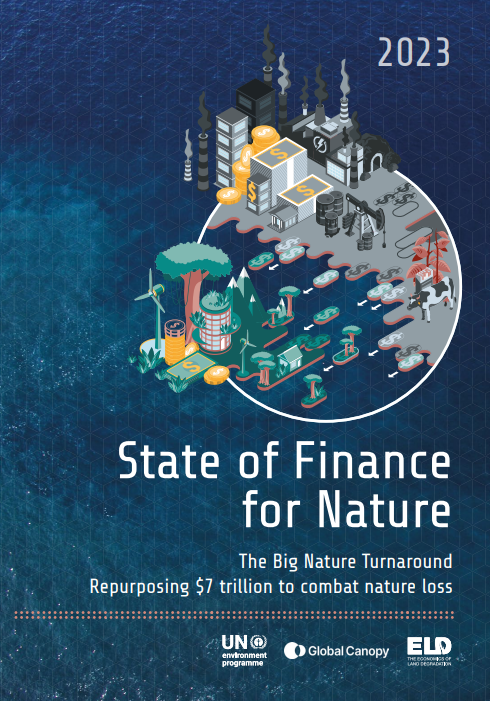The State of Finance for Nature 2023 report begins by critically examining the financial contributions towards nature-based solutions (NbS), contrasting them with the financial flows causing harm to nature. Shockingly, it is estimated that a massive $7 trillion is invested annually in activities directly damaging to nature, while a mere $200 billion was invested in NbS in 2022.
After this initial examination, the report evaluates the current NbS implementation and financing levels. It estimates the funds necessary to protect 30% of the land and sea by 2030 (the 30×30 target) and to achieve land degradation neutrality. Concurrently, it measures how much financial flows from public and private sources harm nature, establishing the NbS finance gap. This gap, importantly, signifies the difference between current financial flows and the scenario aligned with the Rio Conventions.
Key Findings
- Growing Investments, Falling Short: While public and private investment in NbS is increasing, it still falls far short of the estimated $700 billion per year needed to meet global targets for climate, biodiversity, and land degradation neutrality.
- Public vs. Private: Public finance dominates NbS investments, accounting for 70% of current flows. However, private sector involvement is crucial to scale up funding.
- Focus on Forests: Forest-related NbS like conservation and sustainable forest management attract the most significant investments, but other areas like wetlands and coastal ecosystems need more attention.
- Uneven Distribution: Finance flows are concentrated in high-income countries and a few biodiversity hotspots. Greater efforts are needed to direct funding to developing countries facing significant environmental challenges.
Overview of the Report
Chapter 1 The case for a big nature turnaround
Presents an urgent call for transformative action to counteract nature loss. It highlights the dire consequences of inaction, such as biodiversity loss, ecosystem degradation, and impacts on human well-being. Furthermore, it emphasizes the urgency and necessity for a paradigm shift in conserving and restoring nature. It explores the potential of nature-based solutions (NbS) to meet Rio Convention targets. It underscores NbS’s crucial role in mitigating climate change, curbing biodiversity loss, and combating land degradation, spotlighting their potential as cost-effective and high-impact solutions to these global challenges.
Moreover, the chapter sets the foundation for a detailed exploration of finance for nature in subsequent chapters by presenting an initial analysis of the current financial landscape. This introduction paves the way for more in-depth discussions on finance flows and investment needs, reinforcing the importance of redirecting finance to counteract nature loss and foster a future beneficial for both nature and climate.
Chapter 2 How much finance is driving negative impacts on nature
Delves into the adverse effects of finance flows on nature. It opens by acknowledging the challenges in producing comprehensive estimates of these flows due to limitations in data and agreed methodologies. It then provides estimates of public and private finance flows contributing to nature degradation and affecting vulnerable populations. Despite a growing awareness of their scale, finance flows to nature-harming activities continue to expand.
Highlights environmentally harmful public subsidies that sustain unsustainable practices in agriculture, forestry, fishery, and fossil fuels, contradicting commitments to reduce emissions and mitigate biodiversity loss and land degradation through the Rio Conventions. For the first time, it introduces quantifying private finance flows with direct negative impacts on nature. It brings attention to the under-valued and under-priced natural capital and the absence of incentives for its protection and sustainable use, which lead to severe depletion of natural capital.
The chapter emphasises the urgent need to reduce and redirect finance flows that harm nature and society. Insists on the necessity of subsidy reform and alignment of private finance with nature-positive activities and outcomes. Moreover, it underscores the importance of regulatory measures and incentives to ensure private finance aligns with nature-positive activities. Lastly, it stresses the enormity of private finance flows that damage nature and the inadequacy of voluntary actions by businesses and financial institutions.
Chapter 3 How much finance is directed to nature-based solutions
Analyses the current financing for nature-based solutions (NbS) from public and private sources. It starts by offering an overview of the existing financial support for NbS, emphasizing the importance of comprehending the scale and distribution of these funds to tackle global environmental issues. The chapter then delves into the volume and channels of current finance flows to NbS. It highlights a significant gap between existing funding and the investment required to reach Rio Convention targets. It stresses the need for a considerable increase in NbS funding to combat climate change, biodiversity loss, and land degradation effectively.
Also addresses the challenges of mobilizing finance for NbS, including the need for innovative financial instruments to attract private investment and boost public funding. Additionally, the chapter illustrates the potential impact of investing in protection, sustainable land management, and restoration. It underscores the tangible funding available for directly addressing nature loss and protecting critical ecosystems. The analysis also brings to light the well-developed science, evidence, frameworks, and policy tools for NbS, emphasizing the necessity of their implementation by governments, businesses, and financial institutions.
Moreover, the chapter spotlights the importance of incentivizing a shift in finance away from nature-damaging activities and towards nature-positive outcomes. It highlights the growing investment opportunities in NbS through the transformation of sectors such as the global food system, extractive industries, real estate, and infrastructure.
Chapter 4 How much investment in nature-based solutions is needed to reach Rio Targets
Dives into the financial needs of these solutions. Initially, the chapter introduces investment needs modelling, a method that estimates the finance distribution among various nature-based solutions (NbS) for optimal climate and biodiversity target achievement. This analysis considers the potential impacts of various NbS activities such as protection, sustainable land management, and restoration.
Subsequently, an extended scenario analysis is discussed, introducing a new scenario that reflects the likelihood of policy implementation and market trends. This analysis aims to inform stakeholders about the current disbursement to NbS and the additional finance needed. The chapter underscores the importance of acknowledging uncertainties around marine ecosystem restoration potential and the model’s limitations in capturing climate change effects.
Further in the chapter, investment needs for the 16 most impactful NbS activities are estimated. The analysis underscores the urgent need for a substantial increase in finance directed towards NbS to combat climate change, biodiversity loss, and land degradation effectively. It also highlights the potential of NbS in achieving biodiversity and climate targets, emphasizing the successful implementation of the Rio Conventions. In addition, the chapter explores the benefits of investing in NbS, which include cost-effective solutions to environmental issues, enhanced gender equality, poverty reduction, increased resilience, and empowerment of marginalized communities.
Chapter 5: Key findings and recommendations
Provides a thorough overview of the key findings and recommendations. It focuses on the urgent need to counteract nature-negative finance flows and bolster investment in nature-based solutions (NbS) to reach Rio targets and reshape our economic system to be more nature-positive and equitable. The chapter starts by underscoring the scale of nature-negative finance flows, estimated at nearly US$7 trillion annually. This figure significantly overshadows the current finance for NbS, which stands at US$200 billion per year. It highlights a profound discrepancy between finance flows harmful to nature and the investment needed to achieve Rio targets, stressing the necessity for a considerable surge in NbS-directed finance.
Moreover, it emphasizes the importance of a dual approach to this challenge. It advocates for scaling up public and private investment into NbS and curtailing nature-negative capital flows from both sectors. This dual approach is critical in effectively combating climate change, biodiversity loss, and land degradation. Also offers high-level recommendations for policymakers, businesses, and financial institutions. These suggestions aim to mobilize finance for NbS and create incentives for reshaping finance towards nature-positive outcomes. The emphasis is on innovative policy and financial instruments with the highest potential to trigger finance for NbS and effectively counteract nature-negative investment.
Recommendations:
- Big Nature Turnaround Strategy: The report outlines a concrete plan for repurposing the $7 trillion in annual nature-negative investments towards NbS. This involves policy interventions, business incentives to adopt sustainable practices, and innovative financial mechanisms to channel funds to nature-positive projects.
- Strengthening the Global Plastics Treaty: The report emphasizes the importance of a robust UN Global Plastics Treaty to regulate the entire plastic lifecycle, from production and consumption to waste management. This could significantly reduce nature-negative impacts associated with plastics.
- Promoting Circular Economy and Sustainable Consumption: Embracing circular economy principles for materials like plastics and promoting responsible consumption patterns are crucial to decreasing reliance on virgin resources and minimising waste generation.
- Corporate Accountability and Transparency: Businesses need to be accountable for their environmental footprint and adopt transparent reporting practices to track their progress towards sustainability goals. Investing in NbS can be a key part of their corporate responsibility strategy.




